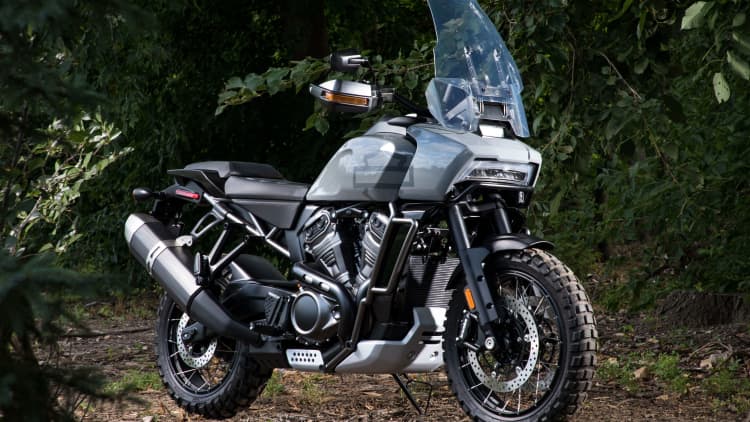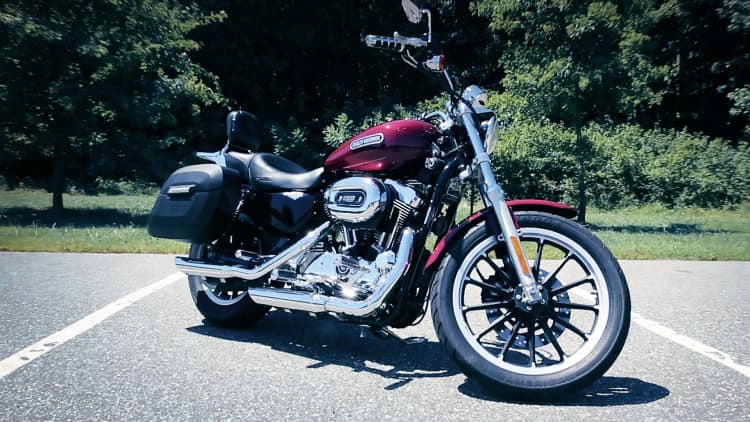
Harley-Davidson CEO Matt Levatich on Monday rolled out an aggressive "more roads to Harley" growth plan that includes an expanded lineup of lighter motorcycles, smaller urban retail stores, a new digital strategy and an international push as U.S. sales fall.
The Wisconsin-based company said it is launching by 2020 a new platform of 500 cc to 1250 cc middleweight bikes and an even smaller bike for emerging markets in Asia. The biggest Harley engines run at around 1,700 cubic centimeters and weigh more than 1,000 pounds — making the new lineup a significant departure from its signature HOGs.
"We're going to be doubling down on existing products. We're going to invest in an all-new middleweight platform, which is a modular chassis and a very core engine technology to go in three dramatically different spaces: adventure touring, custom and street fighter," Levatich said in a wide-ranging interview with CNBC's Morgan Brennan. He also touched on politics and trade and Harley's investments in overseas facilities that have drawn criticism from President Donald Trump.
Harley's shares have fallen nearly 13 percent this year and profits have dropped as the 115-year-old company struggles to find a foothold among millennial buyers, who are turned off by the high prices for the heavy bikes. The 0.7 percent gain in international sales during the second quarter wasn't enough to offset a 6.4 percent decline in the U.S.
The company is expanding its push overseas, particularly in India and China, and it's launching its first electric motorcycle, LiveWire, next year with additional models through 2022. Harley is increasingly investing in production facilities overseas to avoid tariffs. In India, tariffs double the cost of a bike.
Trump has criticized the company's international investments. He said in a July 3 tweet that the administration was working with other motorcycle companies after Harley announced plans in June to move its European market production out of the U.S. because of retaliatory tariffs from the European Union. That was after he stirred up customer anger in a tweet a few days before.
"Harley-Davidson should stay 100% in America, with the people that got you your success. I've done so much for you, and then this. Other companies are coming back where they belong! We won't forget, and neither will your customers or your now very HAPPY competitors," the president tweeted.
Levatich called Trump's statements "unfortunate attention" to some tough decisions the company's had to make in recent years. He said Harley works hard to stay out of politics. "We just deal with what we have to deal with; we are not a political organization. We've worked very hard to be apolitical in how we approach our business and our consumers, everywhere in the world," he said.
While its bikes were once taxed at 6 percent in Europe, the new tariffs raised that to 31 percent. Harley-Davidson was already under pressure because of the Trump administration's tariff that levied a 25 percent tax on steel and aluminum imports. India levies a 100 percent tariff against Harley's motorcycles that are made in the United States. Harley-Davidson has facilities in Brazil, India and Thailand to tap those high-growth, emerging markets.
The company's added costs from the global trade conflict could reach $100 million annually by 2019, according to CFO John Olin.
"While Harley's preference is to manufacture all of its bikes from the U.S.," the company has had to invest in plants overseas over the last 20 years to offset costly tariffs that make its bikes unaffordable in other countries, Levatich said. "We're only doing that because these are important growth markets for the company that without those investments we wouldn't have access to those customers, at any kind of reasonable price."
Bob Lutz, the former vice chairman of General Motors, empathized with Levatich.
"We live in an environment where the framework within which we do business is set by the governments of the world, and that tends to change cost and revenue relationships," he said in an interview on CNBC. "You analyze the situation and you do what you have to do for the shareholders."
The shares barely budged on the announcement, which Levatich hinted would be coming when the company released earnings last week.
Joe Altobello, an analyst with Raymond James, said that's because aspects of the new strategy were predictable, like producing smaller bikes to attract urban consumers and electric motorcycles. "It's kind of a wait and see here" based on if the company can execute its plan and recognize results on its income statement, he said.
WATCH: How big Harley-Davidson is and why it's a trade-war target

CNBC's Robert Ferris contributed to this article.


